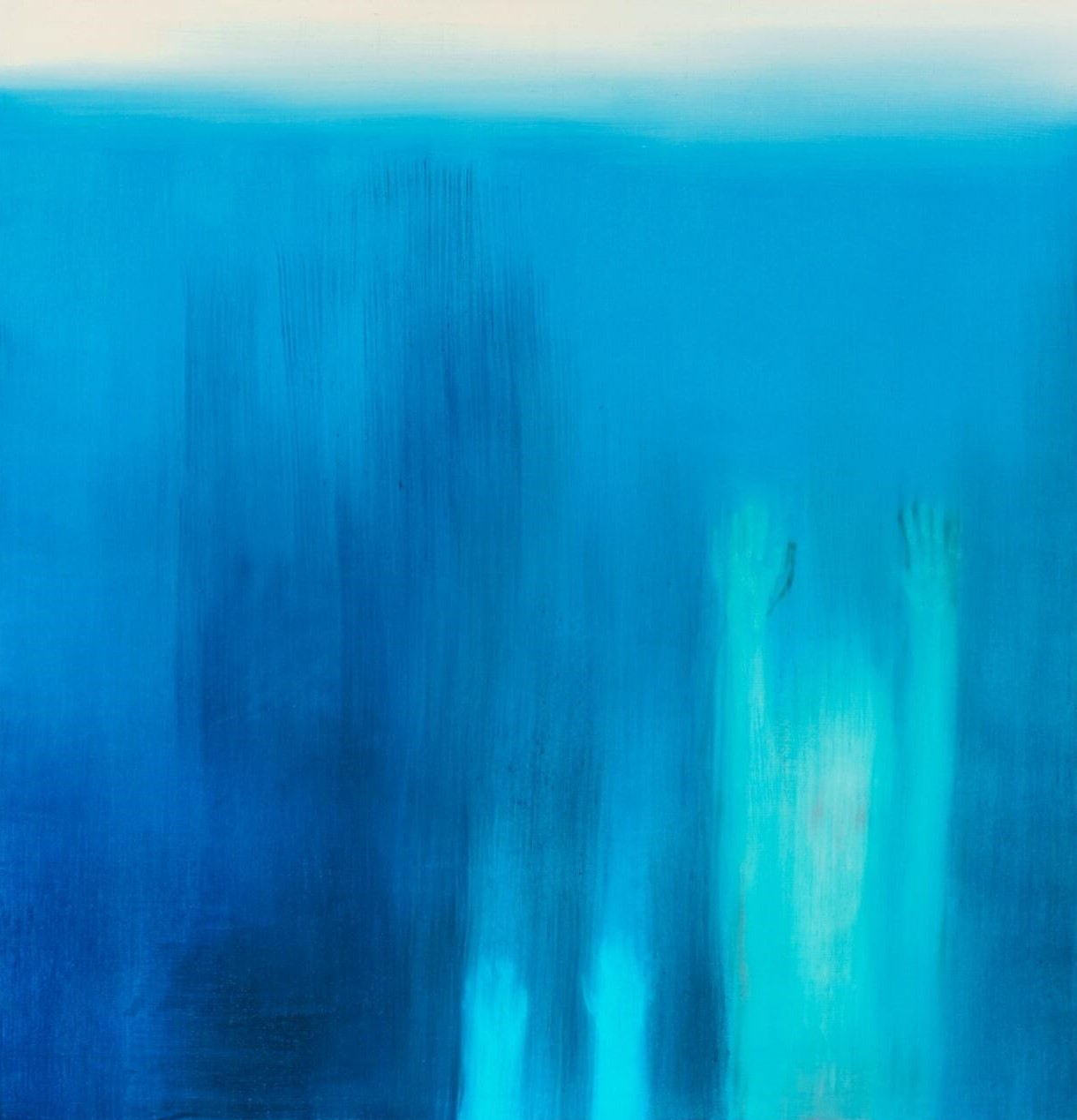ミリアム・カーン
Miriam Cahn
人としての私
2018年1月1日と9日
油彩、キャンバス
200×195 cm
作家蔵
ich als mensch (i as human)
January 1st + 9th, 2018
Oil on canvas
200 x 195 cm
Collection of the artist
Courtesy: WAKO WORKS OF ART, Tokyo
人としての私
2018年1月1日と9日
油彩、キャンバス
200×195 cm
作家蔵
キャンバスいっぱいに素早く力強い筆致で描かれた裸の男女。いずれも素性が知れず、対面の男性を殴りつける女性の表情は怒っているようにも笑っているようにも見えます。カーンは、1970年代の活動初期から男女の身体を描き続けており、1983年より発表しているドローイングを書き溜めたノート(出品作《古典的な愛》[20世紀])にもその軌跡を見ることができます。1994年より制作を始めた油彩画には、大小さまざまな裸体像が登場しています。人物たちは、ジェンダーが固定されることなく、手を取り、抱擁し合う場合もあれば、本作のように力がみなぎるような行為に及ぶ場合もあります。1970年代の女性解放運動への参加に始まり、距離をとりながらも#MeTooを含む近年のフェミニズム運動にも応答してきたカーン。いまだ続く男女不平等と戦いながら、性差に規定されない普遍的な人間としての立ち位置、「人としての私」とは何かという問いを鑑賞者に投げかけます。
ich als mensch (i as human)
January 1st + 9th, 2018
Oil on canvas
200 x 195 cm
Collection of the artist
Courtesy: WAKO WORKS OF ART, Tokyo
A naked man and woman are painted on a canvas with quick and powerful brushstrokes. The expression on the face of the woman, who is punching the man in front of her, seems to suggest that she is both angry and laughing. Cahn has been drawing male and female bodies since the early days of her career in the 1970s, as can be seen in her notebook of drawings (traces of which can also be observed in the exhibited work, d.kl.l. [classical loving], 20th Century), which she began exhibiting in 1983. Nude figures of various sizes appear in the oil paintings that she began working on in 1994. The gender of these figures is not fixed: some of them hold hands and embrace each other, while others are engaged in actions that surge with vitality, as in the present work. Beginning with her participation in the women’s liberation movement during the 1970s, Cahn has also responded to recent feminist movements, including #MeToo, while keeping a certain distance from them. While battling the inequalities that continue to persist between men and women, she asks the viewer to ponder the question “who am I as human” — what one’s universal position is as a human being that is not defined by gender differences.
_美しいブルー_May 13th 2017.jpg)
美しいブルー
2017年5月13日
油彩、キャンバス
200×195 cm
所蔵:ワコウ・ワークス・オブ・アート(東京)
das schöne blau (the beautiful blue)
May 13th, 2017
Oil on canvas
200 x 195 cm
Collection: WAKO WORKS OF ART, Tokyo
美しいブルー
2017年5月13日
油彩、キャンバス
200×195 cm
所蔵:ワコウ・ワークス・オブ・アート(東京)
上部に余白を残し青く塗られた画面には、両手を上げた人物がぼんやりと浮かんでいます。本作は2015年のシリア難民をはじめとする欧州難民危機に応答した作品のひとつで、地中海を彷彿とさせる水色と、力なく海に沈んでいく人々の姿が同居しています。カーンは、1991年の第二次湾岸戦争やユーゴスラビア紛争を目の当たりにした後は、戦争や難民といった暴力に制作を通して応答してきました。そのどれにも、時代や国を特定できる要素は描かれていませんが、画面上の人間の姿は、安住の地を失い、生きるために移動を迫られるなど国家権力の犠牲になったすべての人々だとみなすこともできます。
das schöne blau (the beautiful blue)
May 13th, 2017
Oil on canvas
200 x 195 cm
Collection: WAKO WORKS OF ART, Tokyo
Figures with their hands raised float vaguely within this blue painted surface that leaves a blank space at the top. This work is one of Cahn’s responses to the 2015 refugee crisis in Europe, including that of the Syrian refugees, and the light blue color reminiscent of the Mediterranean Sea coexists with this image of people sinking helplessly into the sea. After having witnessed both the second Gulf War and the Yugoslav Wars in 1991, Cahn responded to the violence of war and refugees through her work. Although none of these paintings depict elements specific to a particular era or country, the human figures in the paintings can all be seen as victims of state power who have lost their safe haven, and are being forced to move in order to survive.
アーティスト一覧ARTISTS
- Etel Adnan|エテル・アドナン
- Phyllida Barlow|フィリダ・バーロウ
- Anna Boghiguian|アンナ・ボギギアン
- Miriam Cahn|ミリアム・カーン
- Lili Dujourie|リリ・デュジュリー
- Anna Bella Geiger|アンナ・ベラ・ガイゲル
- Beatriz González|ベアトリス・ゴンザレス
- Carmen Herrera|カルメン・ヘレラ
- Kim Soun-Gui|キム・スンギ
- Suzanne Lacy|スザンヌ・レイシー
- Mishima Kimiyo|三島喜美代
- Miyamoto Kazuko|宮本和子
- Senga Nengudi|センガ・ネングディ
- Nunung WS|ヌヌンWS
- Arpita Singh|アルピタ・シン
- Robin White|ロビン・ホワイト


